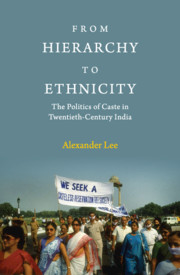Book contents
- Frontmatter
- Dedication
- Contents
- List of Tables
- List of Figures
- Acknowledgements
- 1 Introduction
- 2 Explaining Identity Activism
- 3 Caste in Historical Context
- 4 Caste in the Census of India
- 5 The Causes of Ranked Rhetoric
- 6 Caste since Independence
- 7 Conclusion
- Appendix A Data
- Appendix B Statisical Tests
- Appendix C Additional Tables and Figures
- Bibliography
- Index
5 - The Causes of Ranked Rhetoric
Published online by Cambridge University Press: 14 January 2020
- Frontmatter
- Dedication
- Contents
- List of Tables
- List of Figures
- Acknowledgements
- 1 Introduction
- 2 Explaining Identity Activism
- 3 Caste in Historical Context
- 4 Caste in the Census of India
- 5 The Causes of Ranked Rhetoric
- 6 Caste since Independence
- 7 Conclusion
- Appendix A Data
- Appendix B Statisical Tests
- Appendix C Additional Tables and Figures
- Bibliography
- Index
Summary
The degree to which identity activism embraces ranking is even less understood than the origins of activism itself. In particular, the self-denying nature of ranked identity mobilization is difficult to square with existing theories of what an ethnic identity should look like. The professed goal of ranked petitioners, the complete assimilation of their own group into the higher status category, seems to fly in the face of the incentives proposed by constructivist theories of ethnic politics such as Posner (2004) and Chandra (2004). This chapter describes some basic patterns in the distribution of ranked petitioning, particularly its relationship to the local political environment and the potential position of the groups within that environment.
The set of cases on which we can test these hypotheses quantitatively is a limited one. In order to choose between ranked and unranked rhetoric, a group must first choose to mobilize. In the case of the colonial census data, this means that the analysis is confined to the set of groups that had already petitioned. These cases are analysed within the context of a hierarchical logistic regressionmodel, which takes into account the previouslymade choice to petition. The results show that unranked rhetoric, and the more ‘ethnic’ vision of identity which it implies, is a product of the position of groupswithin the regional political system. Landowning groups and groups with limited contact with the state bureaucracy tended to emphasize hierarchical themes, much as their ancestors had done in pre-colonial times. Large groups in areas with democratic elections, by contrast, did not emphasize hierarchy, prefiguring the type of non-Sanskritic caste politics that became more common after independence. These results are then illustrated by examples of castes that, depending on political circumstance, either remained committed to hierarchical rhetoric or transitioned away from it.
These results are obviously specific to the Indian context: no other country has such an elaborate set of ideas to order social groups, and the specific vocabulary of the varna system is unique to South Asia. However, this chapter shows that both the use of ranked rhetoric and the association between unranked mobilization and political participation are found in other cases as well.
- Type
- Chapter
- Information
- From Hierarchy to EthnicityThe Politics of Caste in Twentieth-Century India, pp. 111 - 131Publisher: Cambridge University PressPrint publication year: 2020



